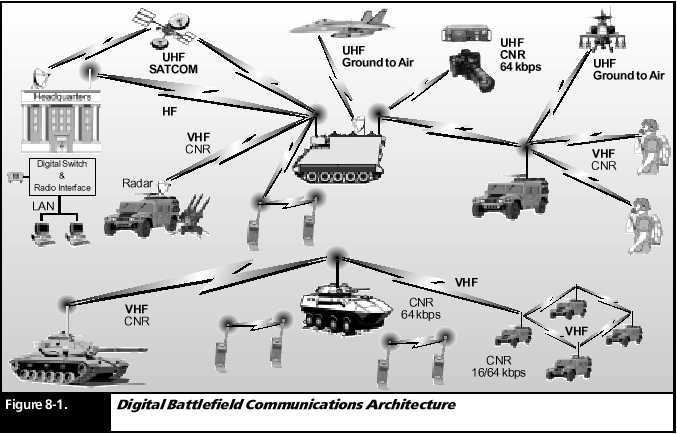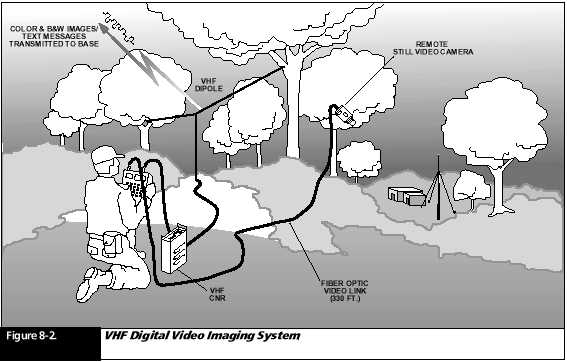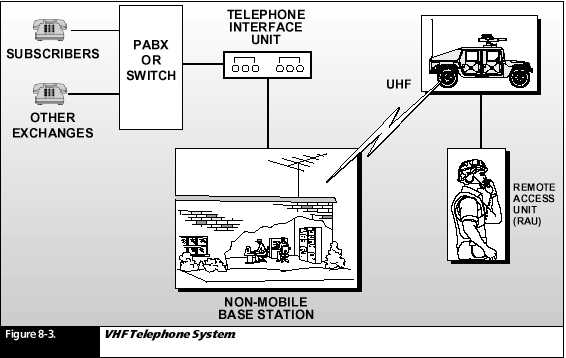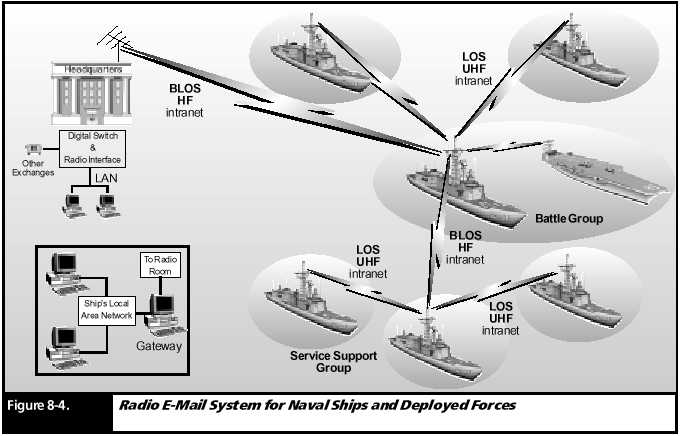
Today’s communications system designer makes use of HF, UHF, VHF, and SATCOM tools and capitalizes on the unique capabilities that each brings to the job. HF radio offers a unique combination of cost effectiveness and versatility for long- haul communications, while VHF/ UHF radio products bring solutions to classical line- of- sight communications requirements.
Recent developments
in digital signal processing and manufacturing
miniaturization
have pushed the technology to smaller, lighter, and less
expensive
equipment. Software- based radio platforms are now able to solve complex
system requirements. This chapter can only touch on a few of the many modern
radio system possibilities available today.

The Digital Battlefield
Figure 8-
1 illustrates a modern battlefield communications network
architecture
that uses SATCOM, UHF, VHF, and HF technologies.
Mobile communications
vehicles provide hubs that receive and retransmit
radio signals
that cover the entire available spectrum. VHF Combat Net
Radios (CNR)
provide ground LOS communications between squads, while UHF radios provide
the same for ground- to- air (G/ A) close support.
Harris VHF/
UHF radios are interoperable with all common waveforms used
in aircraft.
The operator can easily program channels on frequencies for a
G/ A net,
in plain text AM or FM, as well as cipher text AM or FM.
HF and SATCOM
radios provide long haul communications from the front
line back
to theater headquarters. Such a tactical communications network
provides
coverage over distances ranging from less than 50 miles to more
than 1,500
miles.
Individual
elements of this network include frequency hopping, encryption,
and HF Automatic
Link Establishment (ALE) capabilities.
Network requirements
dictate that links are provided between the fixed
headquarters
site and fixed installations for quasi- permanent military
regions and
zones. Provisions are then made for communications between
headquarters
and task forces at fixed, non- permanent, installations.
Lower echelon communications have a combination of fixed, mobile, and man- portable equipment. Frequency management of the network is a headquarters responsibility.
Video Imaging
VHF/ UHF bandwidth
considerations support 16 kbps to 64 kbps within
typical 25
kHz channel, improving the speed in which a text string, file, ora document
can be sent.

Figure 8-
2 shows a scenario in which unattended still- video camera sends images
to an imaging terminal viaan a fiber- optic link. The terminal
captures
and digitizes the image and sends the data to a modem in the
transceiver,
which relays the data to the base. Communications may be via a two- way
link that uses an ARQ protocol to obtain error- free transmission of the
image, or a one- way link in which FEC coding reduces the probability of
error in the received message.
High data
rates for detailed images or maps shorten the on- air time
required
to pass the image files.
The Harris
Universal Image Transmission System (HUITS) digital imaging
product optimizes
the compression of digital images and uses an ARQ
protocol
specifically designed for transmission over tactical radio channels.

VHF/ UHF Telephone System
A VHF or UHF
radio link extends the reach of a telephone network to the
battlefield
as shown in Figure 8- 3. The telephone system enables users to
place calls
to and from mobile radio transceivers in field to commercial
switched
telephone networks or private subscriber telephonethe lines.
Calls from
the field are placed over HF, VHF, or UHF to anywhere in the
world through
the base station telephone switch or exchange. To initiate a call, the
user enters a telephone number just as if the Remote Access Unit
(RAU) was
a telephone set connected directly to the base station telephone
exchange.
At this point,
the number dialed is transmitted through the RAU to the
Telephone
Interface Unit (TIU). As the TIU dials the digits and the target
telephone
rings, the mobile operator hears call progress tones, just as if
a regular
telephone was used.
In order to
contact anyone in the field, a telephone user dials a telephone
number (or
the extension) to which the TIU is connected — from anywhere
in the world.
The TIU automatically answers the call and the user is
connected
directly with the field radio.
Secure communications
can be achieved through interfaces to the com-
mon inventory
of encryption devices. The high data rates available over a
25 kHz VHF
channel improve the intelligibility of wide- band secure voice.
Radio E- mail
Electronic
mail and other inter- networking technologies are becoming
increasingly
important for interoffice communications. However, many
users find
that communications between remote stations are difficult
and/ or expensive,
due to costly telephone or satellite charges. Harris has
developed
radios and systems that are an excellent alternative for providing these
services to distant users or stations. Typical applications include:
Naval ship- to- shore and ship- to- ship communications
Embassy Ministry of Foreign Affairs communications
Oil/ Gas/ Mining operations
In the following
discussion, we will focus on naval applications; similar
configurations
support other radio e- mail and inter- networking
communications
system requirements.

A radio e-
mail system for naval ships and deployed forces that supports
naval communications,
including administrative, logistic, and engineering
order- wire
traffic, is shown in Figure 8- 4.
Local Area
Networks (LANs) within a ship provide an intranet with e- mail
capability
between various on- board duty stations. This LAN can also connect to a
Harris Wireless Gateway, which extends the intranet using
UHF LOS radio
links to the various ships of the group. The Gateway provides seamless
data transfers between common networked applications, such as E- mail and
FTP file transfer, running on geographically separated LANs. HF long haul
BLOS radio links, can extend the group intranet to distant support groups
or to headquarters on shore.
Applications
such as the Harris Wireless Messaging Terminal make the
operator
interface nearly identical to the office environment e- mail
handling
applications. This makes training of personnel easier and message handling
simpler.
System Design Considerations
Harris RF Communications Division has a communications systems engineering department staffed by specialists in the design of custom equipment for the “one- of- a- kind” type of application. The following are some of the factors that systems engineers consider when designing a modern radio system.
System definition
Who are the users?
What is their location?
Are communications one- way or two- way?
What are the interfaces with other communications media?
What is the operating environment (hostile or friendly, rural or urban)?
Transfer of information
What type of traffic is there (voice, data, images)?
Do the priority
levels differ, depending on the message source and/ or
content?
What are the security levels for safeguarding the information?
Message protection and security
What is the correct type of error detection and correction for data?
What type of COMSEC is needed?
Will spread- spectrum or frequency- hopping techniques be used to avoid interception or jamming?
Is excision filtering needed to remove interfering signals?
System availability
What is the probability of transferring messages in real time?
Can alternate routing be used to enhance message availability?
Can lower priority traffic use store- and- forward techniques?
Are there any operational restrictions due to propagation, transmitter power, or other constraints?
Traffic analysis
What are the typical message lengths?
What is the average number of messages per unit of time?
What are the message priorities?
When is the peak traffic?
What are the types of traffic?
Projected growth for each category of traffic
What impact does higher traffic levels have on system implementation?
Are additional nodes and/ or relays necessary?
Impact on message structure
Is the format for data message compatible with traffic requirements?
Include security classification, priority, source, and destination address.
Fixed site
Are the receiving,
transmitting, and control functions collocated
or separate?
Is this a permanent or temporary installation?
Are there any frequency restraints for collocated receivers and transmitters?
What are the staffing requirements?
What are the environmental considerations?
What type of power is available?
Is uninterrupted power a requirement?
Mobile site
Is the equipment designed for a vehicle, ship, shelter, or aircraft?
Are manpacks required?
What are the antenna limitations and constraints?
What are the physical size constraints?
What are the bandwidth and primary power requirements?
What are the environmental considerations?
Communications protocol
Is there a return channel for ARQ?
Is ALE being used?
What are the data protocols?
Equipment selection
Transmitter requirements: Power output, solid state versus tube, broadband or narrowband, allowable distortion, frequency range, tuning speed, remote control?
Receiver requirements: Selectivity, dynamic range, distortion, remote control?
Antenna requirements: Gain, bandwidth, polarization, radiation pattern, available terrain, remote control?
Data communications systems
What is the data rate?
How is data being protected (type of encryption)?
What is the modulation scheme?
Interface to other equipment and systems
What other
equipment is required (fax, data terminal, imaging systems)?
What other
types of systems are involved?
What interfaces are required between HF/ VHF/ UHF radio systems, satellite, or switched telephone networks?
Command and control
Will operation be attended or unattended?
Is self- test required?
Are the transmitter, receiver, and control sites at different places (split site)?
SUMMARY
Modern radios are small and lightweight. Features and capabilities, which formerly required additional equipment, are now fully embedded into the radio transceiver.
HF, VHF/ UHF
and SATCOM radios play key roles in modern worldwide
telecommunications
systems, often working in conjunction with other
media, such
as cellular networks, and telephone landlines.
Radio e- mail is becoming a very important part of military communications systems.
A systems
approach is needed to obtain the best results in designing
a modern
radio communications network.